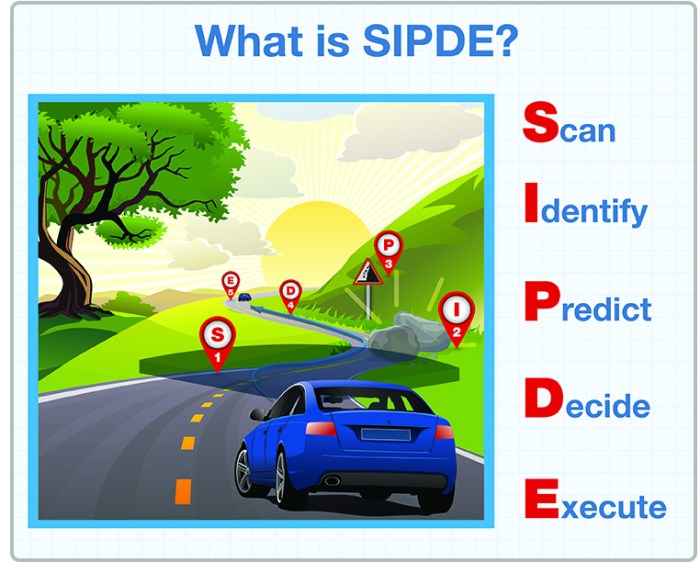The e in sipde stands for – Buckle up and get ready to delve into the world of driver education, where the acronym SIPDE reigns supreme. Today, we’re putting the spotlight on the enigmatic “E” in SIPDE, exploring its significance and how it empowers drivers to navigate the roads with confidence and skill.
SIPDE, an acronym that stands for Search, Identify, Predict, Decide, and Execute, provides a structured approach to driving that emphasizes situational awareness and proactive decision-making. The “E” in SIPDE represents the crucial step of executing the chosen course of action, translating theory into practice and ensuring the safe and efficient operation of a vehicle.
Expansion of the Acronym “SIPDE”
The acronym “SIPDE” stands for “Scanning, Identifying, Predicting, Deciding, and Executing.” It is a framework used in driver education to help drivers make safe and informed decisions while driving.
Scanning
Scanning involves constantly observing the environment around the vehicle, including the road, other vehicles, pedestrians, and potential hazards. This allows drivers to identify potential risks and adjust their driving accordingly.
The e in “sipde” is often misunderstood, but it actually stands for “Electronic Database”. This is a crucial concept in the world of gaming, as it allows players to access information and resources that can help them improve their gameplay.
For example, the Age of Wonders 4 Database is a valuable tool for players who want to learn more about the game’s units, abilities, and strategies. By understanding the e in “sipde”, players can unlock a wealth of knowledge that can help them succeed in their gaming endeavors.
Identifying
Once potential hazards have been identified, drivers need to determine their significance and the likelihood of them becoming a problem. This involves assessing the speed and direction of other vehicles, the condition of the road, and any other factors that could affect safety.
Predicting
Predicting involves anticipating the actions of other drivers and potential hazards based on the information gathered from scanning and identifying. This allows drivers to make informed decisions about how to respond to potential risks.
Deciding
Based on the information gathered from scanning, identifying, and predicting, drivers need to make decisions about how to respond to potential hazards. These decisions may involve changing speed, adjusting lane position, or taking evasive action.
Executing, The e in sipde stands for
Executing involves carrying out the decisions made in the previous step. This may involve braking, accelerating, turning, or other maneuvers necessary to avoid or mitigate potential hazards.
Explanation of the Letter “E” in SIPDE
In the SIPDE framework, the letter “E” stands for “Evaluate.” This crucial step involves assessing the driving situation, making informed decisions, and taking appropriate actions to maintain a safe and efficient journey.
Importance of Evaluation in SIPDE
Evaluation is essential for several reasons:
- Continuous Assessment:It allows drivers to constantly monitor the driving environment and identify potential hazards or changes that require adjustments.
- Decision-Making:Based on the evaluation, drivers can make informed decisions about speed, lane changes, and other maneuvers to mitigate risks.
- Error Detection:Evaluation helps drivers identify any errors or oversights in their driving, enabling them to correct their actions promptly.
- Performance Improvement:By regularly evaluating their driving, drivers can identify areas for improvement and enhance their overall driving skills.
Practical Applications of the “E” Component: The E In Sipde Stands For

The “E” component in SIPDE, which stands for “Evaluate,” plays a crucial role in real-world driving situations. It involves constantly assessing the driving environment, anticipating potential hazards, and making informed decisions to ensure safety.
Enhancing Driver Safety
The “E” component helps drivers identify and respond to potential risks effectively. By continuously evaluating the surroundings, drivers can:
- Identify potential hazards, such as other vehicles, pedestrians, or road conditions, and anticipate their actions.
- Assess the severity of potential hazards and prioritize responses accordingly.
- Make timely and appropriate decisions to avoid or mitigate hazards, such as adjusting speed, changing lanes, or braking.
Comparisons to Other Driver Education Models

The “E” component of SIPDE stands out compared to similar components in other driver education models due to its emphasis on evaluating the current situation and anticipating potential hazards. While other models may incorporate elements of evaluation, SIPDE places a unique focus on actively considering the consequences of actions and making informed decisions based on that evaluation.
Advantages of the “E” Component in SIPDE
One of the key advantages of the “E” component in SIPDE is its comprehensive nature. It encourages drivers to consider not only the immediate hazards but also potential risks that may arise in the future. This proactive approach allows drivers to make more informed decisions and take appropriate actions to mitigate potential dangers.Furthermore,
the “E” component promotes a continuous cycle of evaluation and adjustment. By regularly assessing the situation and anticipating potential hazards, drivers can make necessary adjustments to their driving behavior to maintain safety and avoid accidents. This ongoing evaluation process helps drivers stay alert and responsive to changing conditions on the road.
Visual Representation of the “E” Component

The “E” component in SIPDE stands for “Execute.” It represents the crucial step where the driver translates their decision-making into concrete actions behind the wheel. This involves initiating maneuvers, such as steering, accelerating, braking, or changing lanes, to execute the chosen course of action.
Visual Representation
A simple visual representation of the “E” component can be a flowchart or diagram illustrating the following steps:
-
-*Perception
Receiving and processing information from the surrounding environment.
-*Decision
Analyzing information and selecting an appropriate course of action.
-*Execution
Translating the decision into physical actions behind the wheel.
Potential Enhancements to the “E” Component

The “E” component of SIPDE, representing “Have Been Prepared,” holds significant importance in the driver education model. While it effectively emphasizes the significance of preparation and awareness, there are potential enhancements that could further improve its effectiveness.
One suggestion is to incorporate a proactive approach within the “E” component. This can involve encouraging drivers to anticipate potential hazards and plan their responses accordingly. By fostering a mindset of proactive thinking, drivers can develop a heightened sense of situational awareness and make more informed decisions on the road.
Enhanced Hazard Recognition
To enhance hazard recognition, the “E” component could include specific techniques and exercises designed to improve drivers’ ability to identify potential risks. This could involve incorporating simulations or interactive scenarios that challenge drivers to identify and respond to various hazards in a controlled environment.
Frequently Asked Questions
What is the significance of the “E” in SIPDE?
The “E” in SIPDE represents the execution phase, where drivers put their decisions into action and operate their vehicles safely and efficiently.
How does the “E” component enhance driver safety?
By executing decisions effectively, drivers can avoid potential hazards, respond appropriately to changing conditions, and maintain control of their vehicles.
What are some examples of the “E” component in practice?
Smoothly changing lanes, maintaining a safe following distance, and executing emergency maneuvers are all examples of the “E” component in action.